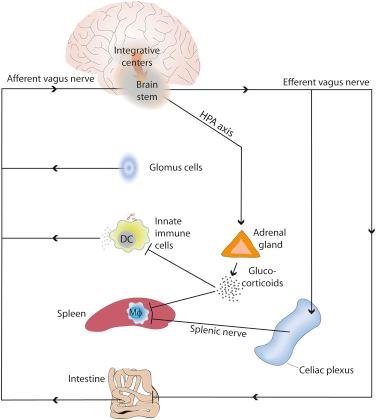Physical Address
304 North Cardinal St.
Dorchester Center, MA 02124
Rheumatoid arthritis (RA) and inflammatory bowel disease (IBD) are chronic autoimmune diseases of complex etiology, affecting approximately 1%–2% of the population. Both diseases cause debilitating symptoms and progressive destruction in the joints and intestinal tract, respectively, severely affecting quality of life. Due to the exacerbating effect of ongoing systemic inflammation, RA patients also carry elevated risk of cardiovascular mortality ( ) while IBD patients have increased incidence of colorectal cancer ( ). Biologic therapies (e.g., tumor necrosis factor (TNF) inhibitors) have greatly improved the care of RA and IBD patients in recent years, yet these drugs are expensive, contain inherent risks of serious off-target effects, and are not effective in all patients. Thus, there remains a significant need for alternative therapeutic approaches.
A recent confluence of immunology, physiology, and neuroscience has led to the discovery of coordinated, autonomic nervous system (ANS) control over inflammation ( ). One way that the central nervous system regulates innate and adaptive immunity is through the “inflammatory reflex,” which senses inflammation in the periphery and responds via its efferent arm, termed the cholinergic antiinflammatory pathway (CAP) ( ). The major neural conduit for both afferent sensing and efferent activity is the vagus nerve, the tenth cranial nerve that emerges from the brainstem to innervate most organs of the viscera ( Fig. 126.1 ). On sensing infection or tissue injury, neural signals are sent through the afferent vagus nerve, processed centrally, and relayed out through efferent vagus neurons, leading to resolution of inflammation through release of humoral cortisol or locally acting neurotransmitters ( ). Intriguingly, tonic vagus nerve activity is decreased in RA, IBD, and other inflammatory diseases ( ).

The CAP has been activated electrically or pharmacologically to reduce pathological inflammation in numerous animal models of disease ( ) and electrically accessing this system via vagus nerve stimulation (VNS) has been proposed as a novel, nonpharmacologic treatment for clinical inflammatory diseases such as RA and IBD ( ).
In this chapter, we will review the biological mechanisms of the inflammatory reflex. We will then present evidence in animal models of RA and IBD of the importance of the CAP in progression of disease and evidence of the use of electrical stimulation of the vagus nerve to ameliorate disease in those models. Finally, we will discuss data from cultured human cell experiments and observational clinical studies that support exploring the use of VNS in patients with RA and IBD.
Become a Clinical Tree membership for Full access and enjoy Unlimited articles
If you are a member. Log in here